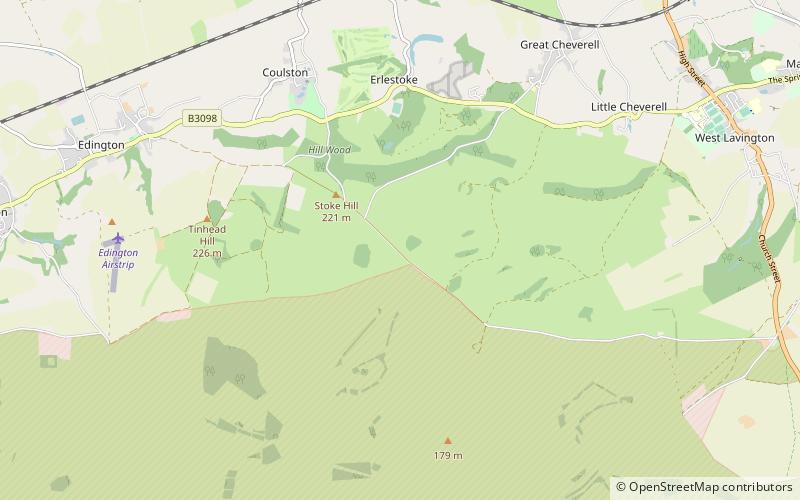Wessex Ridgeway
#3436 among destinations in the United Kingdom


Facts and practical information
The Wessex Ridgeway is a long-distance footpath in southwest England. It runs 136 miles from Marlborough in Wiltshire to Lyme Regis in Dorset, via the northern edge of Salisbury Plain and across Cranborne Chase AONB. The footpath was opened in 1994. ()
EnglandUnited Kingdom
Wessex Ridgeway – popular in the area (distance from the attraction)
Nearby attractions include: Westbury White Horse, Warminster Town Park, Edington Priory, St Giles' Church.
 Hill figure originally cut in the 1600s
Hill figure originally cut in the 1600sWestbury White Horse, Westbury
104 min walk • Westbury or Bratton White Horse is a hill figure on the escarpment of Salisbury Plain, approximately 1.5 mi east of Westbury in Wiltshire, England.
 City hall
City hallWarminster Town Park, Warminster
179 min walk • Warminster Town Hall is a former municipal building in the Market Place of Warminster, Wiltshire, England. The structure, which served as the headquarters of Warminster Urban District Council, is a Grade II listed building.
 Monastery, Church
Monastery, ChurchEdington Priory
63 min walk • Edington Priory in Wiltshire, England, was founded by William Edington, the bishop of Winchester, in 1351 in his home village of Edington, about 3+3⁄4 miles east of the town of Westbury. The priory church was consecrated in 1361 and continues in use as the parish church of Saint Mary, Saint Katharine and All Saints.
 Church
ChurchSt Giles' Church
57 min walk • St Giles' Church in the deserted village of Imber, Wiltshire, England, was built in the late 13th or early 14th century. It is recorded in the National Heritage List for England as a Grade I listed building, and is now a redundant church in the care of the Churches Conservation Trust.
 Concerts and shows, Theater
Concerts and shows, TheaterWarminster Athenaeum, Warminster
179 min walk • Warminster Athenaeum is a Victorian theatre in Warminster, Wiltshire, England, and a Grade II listed building. Built in Jacobean style in 1857/8 to designs by William Jervis Stent, it is held in trust on behalf of the residents of Warminster by a charitable trust and is Wiltshire’s oldest working theatre.
 Archaeological site
Archaeological siteBratton Castle
99 min walk • Bratton Castle is a bivallate Iron Age built hill fort on Bratton Down, at the western edge of the Salisbury Plain escarpment. The hill fort comprises two circuits of ditch and bank which together enclose a pentagonal area of 9.3 hectares.
 Archaeological site
Archaeological siteBattlesbury Camp
144 min walk • Battlesbury Camp is the site of an Iron Age bivallate hill fort on Battlesbury Hill near the town of Warminster in Wiltshire, South West England. Excavations and surveys at the site have uncovered various finds and archaeological evidence.
 Archaeological site
Archaeological siteScratchbury Camp
148 min walk • Scratchbury Camp is the site of an Iron Age univallate hillfort on Scratchbury Hill, overlooking the Wylye valley about 1 km northeast of the village of Norton Bavant in Wiltshire, England.
 Park
ParkBratton House
79 min walk • Bratton House is a grade II* listed country house in Melbourne Street, Bratton, Wiltshire, England. The house dates from 1715 and was built for Philip Ballard. It was enlarged in 1826 for the Seagram family with additional alterations in 1915 and the 1930s.
 Archaeological site
Archaeological siteWhite Barrow
136 min walk • White Barrow is a large Neolithic long barrow just below the crest of Copehill Down on Salisbury Plain, just south of the village of Tilshead in Wiltshire, England. It is a scheduled monument, and is owned by the National Trust. It was the first ancient monument to be purchased by the National Trust.
 Archaeological site
Archaeological siteKnook Castle
126 min walk • Knook Castle is the site of an Iron Age univallate hillfort on Knook Down, near the village of Knook in Wiltshire, England, but within the civil parish of Upton Lovell.
